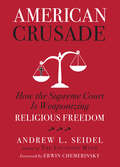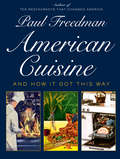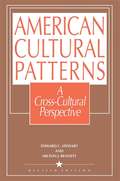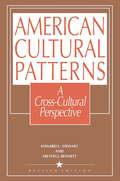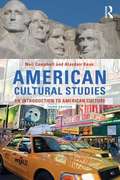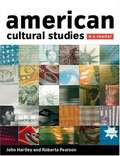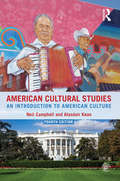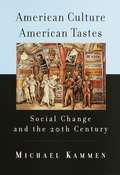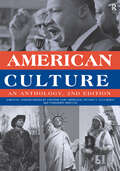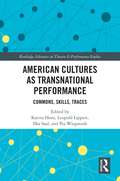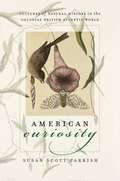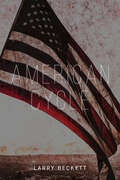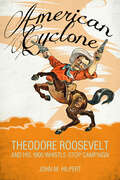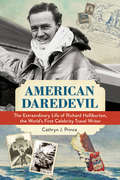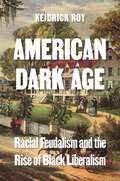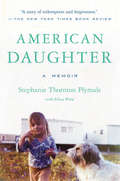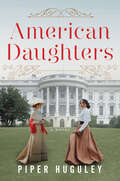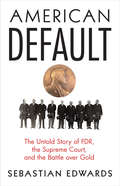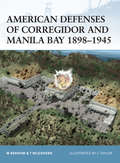- Table View
- List View
American Crusade: How the Supreme Court Is Weaponizing Religious Freedom
by Andrew L SeidelIs a fight against equality and for privilege a fight for religious supremacy? Andrew L. Seidel, a constitutional attorney and author of the critically acclaimed book The Founding Myth: Why Christian Nationalism Is Un-American, dives into the debate on religious liberty, the modern attempt to weaponize religious freedom, and the Supreme Court's role in that &“crusade.&” Seidel examines some of the key Supreme Court cases of the last thirty years—including Masterpiece Cakeshop v. Colorado Civil Rights Commission (a bakery that refused to make a wedding cake for a gay couple), Trump v. Hawaii (the anti-Muslim travel ban case), American Legion v. American Humanist Association (related to a group maintaining a 40-foot Christian cross on government-owned land), and Tandon v. Newsom (a Santa Clara Bible group exempted from Covid health restrictions), as well as the recent overturning of Roe v. Wade—and how a hallowed legal protection, freedom of religion, has been turned into a tool to advance privilege and impose religion on others. This is a meticulously researched and deeply insightful account of our political landscape with a foreword provided by noted constitutional scholar Erwin Chemerinsky, author of The Case Against the Supreme Court.The issue of church versus state is more relevant than ever in today&’s political climate and with the conservative majority status of the current Supreme Court. This book is a standout on the shelf for fans of Michelle Alexander, Bob Woodward, and Christopher Hitchens. Readers looking for critiques of the rise of Christian nationalism, like Jesus and John Wayne, and examinations like How Democracies Die will devour Seidel's analysis.Hardcover with dust jacket; 320 pages; 9 in H by 6 in W.
American Crusade: Our Fight to Stay Free
by Pete HegsethJoin the political and cultural fight for America's freedom -- and learn how to protect our nation from the leftist agenda -- with this essential guide from Fox & Friends Weekend co-host Pete Hegseth. <P><P>In American Crusade, Pete Hegseth explores whether the election of President Donald J. Trump was sign of a national rebirth, or instead the final act of a nation that has surrendered to Leftists who demand socialism, globalism, secularism, and politically-correct elitism. Can real America still win? And how? <P><P>Hegseth is an old-school patriot who is on a mission to do his part to save our Republic. This book celebrates all that America stands for, while motivating and mustering fellow patriots to stand ready to defend -- and save -- our great country. As he travels around the country talking to American citizens from all walks of life, Hegseth reveals the common wisdom of average Americans -- and how ready they are to join the cultural battlefield. <P><P> Now is that time, and Hegseth has written the playbook. American Crusade is written with the same insight, politically incorrect candor, and humor that has made his television show one of the most highly-rated in America. <P><P><b>A New York Times Bestseller</b>
American Cuisine: And How It Got This Way
by Paul FreedmanWith an ambitious sweep over two hundred years, Paul Freedman’s lavishly illustrated history shows that there actually is an American cuisine. For centuries, skeptical foreigners—and even millions of Americans—have believed there was no such thing as American cuisine. In recent decades, hamburgers, hot dogs, and pizza have been thought to define the nation’s palate. Not so, says food historian Paul Freedman, who demonstrates that there is an exuberant and diverse, if not always coherent, American cuisine that reflects the history of the nation itself. Combining historical rigor and culinary passion, Freedman underscores three recurrent themes—regionality, standardization, and variety—that shape a completely novel history of the United States. From the colonial period until after the Civil War, there was a patchwork of regional cooking styles that produced local standouts, such as gumbo from southern Louisiana, or clam chowder from New England. Later, this kind of regional identity was manipulated for historical effect, as in Southern cookbooks that mythologized gracious “plantation hospitality,” rendering invisible the African Americans who originated much of the region’s food. As the industrial revolution produced rapid changes in every sphere of life, the American palate dramatically shifted from local to processed. A new urban class clamored for convenient, modern meals and the freshness of regional cuisine disappeared, replaced by packaged and standardized products—such as canned peas, baloney, sliced white bread, and jarred baby food. By the early twentieth century, the era of homogenized American food was in full swing. Bolstered by nutrition “experts,” marketing consultants, and advertising executives, food companies convinced consumers that industrial food tasted fine and, more importantly, was convenient and nutritious. No group was more susceptible to the blandishments of advertisers than women, who were made feel that their husbands might stray if not satisfied with the meals provided at home. On the other hand, men wanted women to be svelte, sporty companions, not kitchen drudges. The solution companies offered was time-saving recipes using modern processed helpers. Men supposedly liked hearty food, while women were portrayed as fond of fussy, “dainty,” colorful, but tasteless dishes—tuna salad sandwiches, multicolored Jell-O, or artificial crab toppings. The 1970s saw the zenith of processed-food hegemony, but also the beginning of a food revolution in California. What became known as New American cuisine rejected the blandness of standardized food in favor of the actual taste and pleasure that seasonal, locally grown products provided. The result was a farm-to-table trend that continues to dominate. “A book to be savored” (Stephen Aron), American Cuisine is also a repository of anecdotes that will delight food lovers: how dry cereal was created by William Kellogg for people with digestive and low-energy problems; that chicken Parmesan, the beloved Italian favorite, is actually an American invention; and that Florida Key lime pie goes back only to the 1940s and was based on a recipe developed by Borden’s condensed milk. More emphatically, Freedman shows that American cuisine would be nowhere without the constant influx of immigrants, who have popularized everything from tacos to sushi rolls. “Impeccably researched, intellectually satisfying, and hugely readable” (Simon Majumdar), American Cuisine is a landmark work that sheds astonishing light on a history most of us thought we never had.
American Cultural Patterns: A Cross-Cultural Perspective
by Milton J. Bennett Edward C. StewartThis classic study was originally written by Edward Stewart in 1972 and has become a seminal work in the field of intercultural relations. In this edition, Stewart and Milton J. Bennett have greatly expanded the analysis of American cultural patterns by introducing new cross-cultural comparisons and drawing on recent reseach on value systems, perception psychology, cultural anthropology, and intercultural communication. Beginning with a discussion of the issues relative to contact between people of different cultures, the authors examine the nature of cultural assumptions and values as a framework for cross-cultural analysis. They then analyze the human perceptual process, consider the influence of language on culture, and discuss nonverbal behavior. Central to the book is an analysis of American culture constructed along four dimentions: form of activity, form of social relations, perceptions of the world, and perception of the self. American cultural traits are isolated out, analyzed, and compared with parallel characteristics of other cultures. Finally, the cultural dimentions of communication and their implications for cross-cultural interaction are examined.
American Cultural Patterns: A Cross-Cultural Perspective
by Milton J. Bennett Edward C. StewartThis classic study was originally written by Edward Stewart in 1972 and has become a seminal work in the field of intercultural relations. In this edition, Stewart and Milton J. Bennett have greatly expanded the analysis of American cultural patterns by introducing new cross-cultural comparisons and drawing on recent reseach on value systems, perception psychology, cultural anthropology, and intercultural communication. Beginning with a discussion of the issues relative to contact between people of different cultures, the authors examine the nature of cultural assumptions and values as a framework for cross-cultural analysis. They then analyze the human perceptual process, consider the influence of language on culture, and discuss nonverbal behavior. Central to the book is an analysis of American culture constructed along four dimentions: form of activity, form of social relations, perceptions of the world, and perception of the self. American cultural traits are isolated out, analyzed, and compared with parallel characteristics of other cultures. Finally, the cultural dimentions of communication and their implications for cross-cultural interaction are examined.
American Cultural Pluralism and Law (Second Edition)
by Serena Nanda Jill NorgrenAn important text for courses in American Government, society and the law, cultural studies, and civil rights. - Back Cover
American Cultural Studies
by Neil Campbell Alasdair KeanThis third edition of American Cultural Studies has been updated throughout to take into account the developments of the last six years, providing an introduction to the central themes in modern American culture and explores how these themes can be interpreted. Chapters in the book discuss the various aspects of American cultural life such as religion, gender and sexuality, and regionalism. Updates and revisions include: discussion of Barack Obama's rise to power and the end of the 'Bush Years', consideration of 'Hemispheric American Studies' and the increasing debates about globalisation and the role of the USA, up-to-date case-studies, such as The Wire and Nurse Jackie, more on suburbia, the Mexican-border crossing, the Twilight phenomena etc, updated further-reading lists. Accompanying website. American Cultural Studies is a core text and an accessible introduction to the interdisciplinary study of American culture.
American Cultural Studies: A Reader
by John Hartley Roberta E. Pearson Eva ViethThis provocative new collection shows how the burgeoning field of cultural studies has developed in the U. S. Introducing vital concepts, arguments, theories, and disciplinary debates, American Cultural Studies: A Reader is a panorama of great writing and powerful ideas. It illustrates a uniquely American response to questions of power and identity in the politics of culture. More than forty selections from key figures in "new journalism," cultural theory, the social sciences, humanities, and visual arts are gathered together in seven sections, each one introduced by helpful notes. A general introductory chapter explains the editorial selection and offers a new account of cultural studies and American studies in relation to American culture. The Epilogue suggests new ways--via the Internet--of doing cultural studies and of thinking about America.
American Cultural Studies: An Introduction to American Culture
by Neil Campbell Alasdair KeanExploring the central themes in modern American cultural studies and discussing how these themes can be interpreted, American Cultural Studies offers a wide-ranging overview of different aspects of American cultural life such as religion, gender and sexuality, regionalism, and ethnicity and immigration. The fourth edition has been revised throughout to take into account the developments of the last four years. Updates and revisions include: discussion of Barack Obama's time in the White House consideration of 'Hemispheric American Studies' and the increasing debates about globalisation and the international role of the USA long-form television and American Studies up-to-date case studies, such as Girls, The Wire and Orange is the New Black more material on Detroit, the Mexican border, same-sex relationships and Islam in America updated further reading lists and new follow-up work. Illustrated throughout, containing follow-up questions and further reading at the end of each chapter, and accompanied by a companion website (www.routledge.com/cw/campbell) providing further study resources, American Cultural Studies is a core text and an accessible guide to the interdisciplinary study of American culture.
American Culture Transformed
by Priscilla L. Walton Bruce TuckerThe bombing of the Twin Towers in New York on September 11, 2001, marked a major turning point in modern American culture. Authors Bruce Tucker and Priscilla L. Walton examine critical moments in the aftermath of 9/11 arguing that commentators abandoned complexity, seeking to reduce events to their simplest signification.
American Culture, American Tastes: Social Change and the 20th Century
by Michael KammenAmericans have a long history of public arguments about taste, the uses of leisure, and what is culturally appropriate in a democracy that has a strong work ethic. Michael Kammen surveys these debates as well as our changing taste preferences, especially in the past century, and the shifting perceptions that have accompanied them.Professor Kammen shows how the post-traditional popular culture that flourished after the 1880s became full-blown mass culture after World War II, in an era of unprecedented affluence and travel. He charts the influence of advertising and opinion polling; the development of standardized products, shopping centers, and mass-marketing; the separation of youth and adult culture; the gradual repudiation of the genteel tradition; and the commercialization of organized entertainment. He stresses the significance of television in the shaping of mass culture, and of consumerism in its reconfiguration over the past two decades.Focusing on our own time, Kammen discusses the use of the fluid nature of cultural taste to enlarge audiences and increase revenues, and reveals how the public role of intellectuals and cultural critics has declined as the power of corporate sponsors and promoters has risen. As a result of this diminution of cultural authority, he says, definitive pronouncements have been replaced by divergent points of view, and there is, as well, a tendency to blur fact and fiction, reality and illusion.An important commentary on the often conflicting ways Americans have understood, defined, and talked about their changing culture in the twentieth century.
American Culture: An Anthology
by Anders Breidlid Fredrik Chr. Brøgger Oyvind T. Gulliksen Torbjorn SirevagThis second edition of American Culture includes contemporary events and provides an introduction to American civilization. Extracts are taken from diverse sources such as political addresses, articles, interviews, oral histories and advertisements. Edited by academics who are highly experienced in the study and teaching of American Studies across a wide range of institutions, this book provides: texts that introduce aspects of American society in a historical perspective primary sources and images that can be used as the basis for illustration, analysis and discussion linking text which stresses themes rather than offering a simple chronological survey. American Culture brings together primary texts from 1600 to the present day to present a comprehensive overview of, and introduction to, American culture.
American Cultures as Transnational Performance: Commons, Skills, Traces (Routledge Advances in Theatre & Performance Studies)
by Katrin Horn Ilka Saal Pia Wiegmink Leopold LippertThis book investigates transnational processes through the analytic lens of cultural performance. Structured around key concepts of performance studies––commons, skills, and traces––this edited collection addresses the political, normative, and historical implications of cultural performances beyond the limits of the (US) nation-state. These three central aspects of performance function as entryways to inquiries into transnational processes and allow the authors to shift the discussion away from text-centered approaches to intercultural encounters and to bring into focus the dynamic field that opens up between producer, art work, context, setting, and audience in the moment of performance as well as in its afterlife. The chapters provide fresh, performance-based approaches to notions of transcultural mobility and circulation, transnational cultural experience and knowledge formation, transnational public spheres, and identities’ rootedness in both specific local places and diasporic worlds beyond the written word. This book will be of great interest to scholars and students of American studies, performance studies, and transnational studies
American Curiosity
by Susan Scott ParrishColonial America presented a new world of natural curiosities for settlers as well as the London-based scientific community. In American Curiosity, Susan Scott Parrish examines how various peoples in the British colonies understood and represented the natural world around them from the late sixteenth century through the eighteenth. Parrish shows how scientific knowledge about America, rather than flowing strictly from metropole to colony, emerged from a horizontal exchange of information across the Atlantic.Delving into an understudied archive of letters, Parrish uncovers early descriptions of American natural phenomena as well as clues to how people in the colonies construed their own identities through the natural world. Although hierarchies of gender, class, institutional learning, place of birth or residence, and race persisted within the natural history community, the contributions of any participant were considered valuable as long as they supplied novel data or specimens from the American side of the Atlantic. Thus Anglo-American nonelites, women, Indians, and enslaved Africans all played crucial roles in gathering and relaying new information to Europe. Recognizing a significant tradition of nature writing and representation in North America well before the Transcendentalists, American Curiosity also enlarges our notions of the scientific Enlightenment by looking beyond European centers to find a socially inclusive American base to a true transatlantic expansion of knowledge.
American Cycle: Version 2
by Larry BeckettAmerican Cycle, a sequence of long poems inspired by our folklore and past, was written over forty-seven years. Its themes are love, local mythology, history, justice, memory, accomplishment, time. "The books are extraordinary, sustained explosions of authentic American language and energy. Each is entirely different from the others in style, voice, form and narrative content; each so rich in imagery and nuance and texture and event and so finely crafted. . . " —Paul Williams, author of Bob Dylan: Performing Artist.American Cycle holds Spanish words loaned from Old California, rough colloquialisms in Paul Bunyan, the power of African-American vernacular English in John Henry, bare oratory in Chief Joseph, old west phrases in Wyatt Earp, circus ballyhoo in P. T. Barnum, aviation jargon in Amelia Earhart, backwoods dialect in Blue Ridge. As Walt Whitman says, "I hear America singing, the varied carols. . .”
American Cyclone: Theodore Roosevelt and His 1900 Whistle-Stop Campaign
by John M. HilpertWhen Theodore Roosevelt entered national politics as the Republicans' nominee for the vice presidency in 1900, he was only forty-one years old. However, he had caught the public's attention with the popular version of his life story. Child of East Coast privilege. Sickly, bespectacled youth. Naturalist and author. Harvard graduate. New York assemblyman. Young widower. Badlands cowboy. Civil Service reformer. Urban police commissioner. Assistant Secretary of the Navy. Rough Rider and war hero. Enemy of political bosses as governor of the nation's most important state. Attentive husband to his second wife, Edith, and the father of six children. Few candidates for the presidency or vice presidency have enjoyed the elevated level of admiration accorded Roosevelt in the waning days of the nineteenth century. Biographers have chronicled every significant period of Roosevelt's life with one exception, and American Cyclone fills that gap. His nomination for the vice presidency was Roosevelt's debut as a candidate for national office. American Cyclone presents the story of his campaign, a whirlwind effort highlighted by an astounding whistle-stop tour of 480 communities across twenty-three states. Eighteen of those states gave a plurality of votes to the McKinley-Roosevelt ticket, a gain of five states for the Republicans over 1896. Everywhere Roosevelt went, admiring throngs and dramatic events helped forge him into the man who would soon be the twenty-sixth president of the United States. Returning from the war, Roosevelt was familiar to millions of people across the country as a determined leader. As he interacted with crowds of hundreds, thousands, and even tens of thousands, Roosevelt felt their eagerness to see and hear him. Accordingly, for the first time, this whistle-stop campaign marks the development of the confidence and maturity that would transform Roosevelt into a national leader.
American Daredevil: The Extraordinary Life of Richard Halliburton, the World's First Celebrity Travel Writer
by Cathryn PrinceWith a polished walking stick and neatly pressed trousers, Richard Halliburton served as an intrepid globetrotting guide for millions of Americans in the 1920s and '30s. Readers waited with bated breath for each new article and book he wrote. During his career, Halliburton climbed the Matterhorn, nearly fell out of his plane while shooting the first aerial photographs of Mt. Everest, and became the first person to swim the Panama Canal. With his matinee idol looks, the Tennessee native was a media darling in an era of optimism and increased social openness. But as the Great Depression and looming war pushed America toward social conservatism, Halliburton more actively worked to hide his homosexuality, burnishing his image as a masculine trailblazer. As chronicled in American Daredevil, Halliburton harnessed the media of his day to gain and maintain a widespread following long before our age of the 24-hour news cycle, and thus became the first celebrity adventure journalist. And during the darkest hours of the Great Depression, Halliburton did something remarkable: he inspired generations of authors, journalists, and everyday people who dreamt of fame and glory to explore the world.
American Dark Age: Racial Feudalism and the Rise of Black Liberalism
by Keidrick RoyHow medieval-inspired racial feudalism reigned in early America and was challenged by Black liberal thinkersThough the United States has been heralded as a beacon of democracy, many nineteenth-century Americans viewed their nation through the prism of the Old World. What they saw was a racially stratified country that reflected not the ideals of a modern republic but rather the remnants of feudalism. American Dark Age reveals how defenders of racial hierarchy embraced America&’s resemblance to medieval Europe and tells the stories of the abolitionists who exposed it as a glaring blemish on the national conscience.Against those seeking to maintain what Frederick Douglass called an &“aristocracy of the skin,&” Keidrick Roy shows how a group of Black thinkers, including Frances Ellen Watkins Harper, Hosea Easton, and Harriet Jacobs, challenged the medievalism in their midst—and transformed the nation&’s founding liberal tradition. He demonstrates how they drew on spiritual insight, Enlightenment thought, and a homegrown political philosophy that gave expression to their experiences at the bottom of the American social order. Roy sheds new light on how Black abolitionist writers and activists worked to eradicate the pernicious ideology of racial feudalism from American liberalism and renew the country&’s commitment to values such as individual liberty, social progress, and egalitarianism.American Dark Age reveals how the antebellum Black liberal tradition holds vital lessons for us today as hate groups continue to align themselves with fantasies of a medieval past and openly call for a return of all-powerful monarchs, aristocrats, and nobles who rule by virtue of their race.
American Daughter
by Elizabeth KendallIn this beautifully crafted book, Elizabeth Kendall tells the story of a family, of a passionate attachment between a mother and a daughter and the sudden tragedy that tears it apart. American Daughter is also a brilliant portrait of wellborn women's lives in cities and towns in the post-World War II era, as Kendall evokes how difficult it was to become anything other than an American daughter, which meant being a dependent woman. Occupying a coveted place in St. Louis's privileged high society, Henry and Betty Kendall seemed to be the American dream come true: six children, a sprawling house, a legacy of higher education at Harvard and Vassar. Yet underneath lay the flawed marriage of an idealistic young woman who made her eldest daughter her best friend and turned civil rights into her salvation. Elizabeth maintained the family silence as eccentricities began to appear in her father's behavior, along with whispers of financial difficulties. She accompanied her mother back to Vassar for a summer program on the home and family, then came into her own, away from her family, at the haven of a girls' summer camp and at Radcliffe. From the war-torn 1940s, when young men in uniform, home on leave, went to debutante parties, through the seismic social changes of the 1960s, Kendall tells the intertwined story of her mother and herself, of their powerful bond and how both shaped their lives in response to it. Unrelentingly honest, rich with humor and insights into families and women's lives, American Daughter is both a poignant portrait of American life at the middle of the twentieth century, and a dual coming-of-age story of a mother and a daughter, united by commitment and love, separated by a fatal accident-and by the vastly different birthrights of their generations.From the Hardcover edition.
American Daughter Gone to War: On the Front Lines with an Army Nurse in Vietnam
by Winnie SmithA former member of the Army Nurse Corps in Vietnam recalls her tour of duty and her difficult adjustment to civilian life.
American Daughter: A Memoir
by Elissa Wald Stephanie Thornton Plymale"Gut-wrenching and absorbing...in the vein of Educated and The Glass Castle."—BOOKLIST"a story of redemption and forgiveness."—MARY BETH KEANE, NEW YORK TIMES BOOK REVIEW"Impressive...Readers will find themselves recalibrating their judgments about villains and victims"–—BOOKPAGE (STARRED REVIEW)For 50 years, Stephanie Plymale kept her past a fiercely guarded secret. No one outside her immediate family would have guessed that her childhood was fraught with every imaginable hardship: a mentally ill mother who was in and out of jails and psych wards throughout Stephanie's formative years, neglect, hunger, poverty, homelessness, truancy, foster homes, a harrowing lack of medical care, and worse.Stephanie, in turn, knew very little about the past of her mother, from whom she remained estranged during most of her adult life. All this changed with a phone call that set a journey of discovery in motion, leading to a series of shocking revelations that forced Stephanie to revise the meaning of almost every aspect of her very compromised childhood.American Daughter is at once the deeply moving memoir of a troubled mother-daughter relationship and a meditation on resilience, transcendence, and redemption. Stephanie's story is unique but its messages are universal, offering insight into what it means to rise above, heal, and forgive.
American Daughters: A Novel
by Piper HuguleyIn the vein of America’s First Daughter, Piper Huguley’s historical novel delves into the remarkable friendship of Portia Washington and Alice Roosevelt, the daughters of educator Booker T. Washington and President Teddy Roosevelt.At the turn of the twentieth century, in a time of great change, two women—separated by societal status and culture but bound by their expected roles as the daughters of famed statesmen—forged a lifelong friendship. Portia Washington’s father Booker T. Washington was formerly enslaved and spent his life championing the empowerment of Black Americans through his school, known popularly as Tuskegee Institute, as well as his political connections. Dedicated to her father’s values, Portia contributed by teaching and performing spirituals and classical music. But a marriage to a controlling and jealous husband made fulfilling her dreams much more difficult. When Theodore Roosevelt assumed the presidency, his eldest daughter Alice Roosevelt joined him in the White House. To try to win her father’s approval, she eagerly jumped in to help him succeed, but Alice’s political savvy and nonconformist behavior alienated as well as intrigued his opponents and allies. When she married a congressman, she carved out her own agendas and continued espousing women’s rights and progressive causes. Brought together in the wake of their fathers’ friendship, these bright and fascinating women helped each other struggle through marriages, pregnancies, and political upheaval, supporting each other throughout their lives. A provocative historical novel and revealing portrait, Piper Huguley’s American Daughters vividly brings to life two passionate and vital women who nurtured a friendship that transcended politics and race over a century ago.
American Deadline: Reporting from Four News-Starved Towns in the Trump Era (Columbia Journalism Review Books)
by Charles Richardson Greg Glassner Sandra Sanchez Jason TogyerThe dramatic events of 2020—the presidential election, the COVID-19 pandemic, protests for racial justice—affected every corner of American life. What did these events mean for the residents of small towns and cities that are often overlooked by national newspapers? How do local stories change when they are told by journalists with roots in these communities? And what is lost as this kind of coverage disappears?American Deadline brings together dispatches from four longtime local journalists in different parts of the United States that tell the story of 2020 anew. It shares reporting from Bowling Green, Virginia; Macon, Georgia; McKeesport, Pennsylvania; and McAllen, Texas—two towns that lost their local newspapers and two where they are barely hanging on. The authors consider what makes each town distinctive and how these local perspectives tell a part of a broader American story. This book reports on how residents of these towns grapple with and talk about issues relating to race, schooling, health, immigration, deindustrialization, as well as local and national politics amid a changing and increasingly precarious information ecosystem. A distinct and intimate look at a calamitous year, American Deadline is an important book for all readers interested in the possibilities and future of local journalism.
American Default: The Untold Story of FDR, the Supreme Court, and the Battle over Gold
by Sebastian EdwardsThe untold story of how FDR did the unthinkable to save the American economyThe American economy is strong in large part because nobody believes that America would ever default on its debt. Yet in 1933, Franklin D. Roosevelt did just that, when in a bid to pull the country out of depression, he depreciated the U.S. dollar in relation to gold, effectively annulling all debt contracts. American Default is the story of this forgotten chapter in America's history.Sebastian Edwards provides a compelling account of the economic and legal drama that embroiled a nation already reeling from global financial collapse. It began on April 5, 1933, when FDR ordered Americans to sell all their gold holdings to the government. This was followed by the abandonment of the gold standard, the unilateral and retroactive rewriting of contracts, and the devaluation of the dollar. Anyone who held public and private debt suddenly saw its value reduced by nearly half, and debtors--including the U.S. government—suddenly owed their creditors far less. Revaluing the dollar imposed a hefty loss on investors and savers, many of them middle-class American families. The banks fought back, and a bitter battle for gold ensued. In early 1935, the case went to the Supreme Court. Edwards describes FDR's rancorous clashes with conservative Chief Justice Charles Evans Hughes, a confrontation that threatened to finish the New Deal for good—and that led to FDR's attempt to pack the court in 1937.At a time when several major economies never approached the brink of default or devaluing or recalling currencies, American Default is a timely account of a little-known yet drastic experiment with these policies, the inevitable backlash, and the ultimate result.
American Defenses of Corregidor and Manila Bay 1898-1945
by Chris Taylor Mark BerhowThe Philippines were declared an American Territory on January 4, 1899, and fortification construction soon began on the islands in the mouth of Manila Bay. Among the sites built were Fort Mills (Corregidor), Fort Frank, and the formidable "concrete battleship" of Fort Drum. The defenses suffered constant Japanese bombardment during World War II, leading to the surrender of American forces. In 1945 the forts were manned by Japanese soldiers determined to hold out to the bitter end. This title details the fortifications of this key strategic location, and considers both their effectiveness and historical importance.
